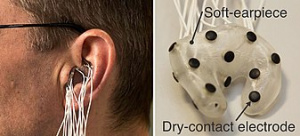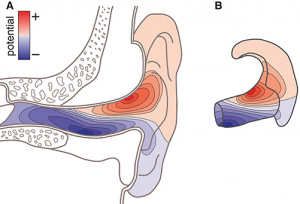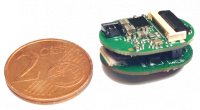In-ear EEG signal acquisition
From iis-projects
Contents
Short Description
Electroencephalography (EEG) is a powerful non-invasive method for monitoring the brain's electrical activity. Traditionally, electrodes are placed on the scalp to capture these electrical patterns, enabling crucial insights into brain function across diverse medical fields. While EEG has been invaluable in research and clinical settings, its wider integration into everyday life has been hampered by the inconvenience of traditional scalp-based electrodes. The aim of this project is to explore the feasibility of in-ear EEG electrodes as a more comfortable and unobtrusive alternative. We'll utilize BioGAP, a compact platform for acquiring and processing biosignals, powered by GAP9, an ultra-low-power System-on-Chip (SoC). BioGAP encompasses all necessary components for measuring and processing EEG signals and can be utilized for in vivo testing.
The project involves experimenting with various in-ear electrodes to determine their effectiveness in capturing EEG signals. The goal is to assess the performance of different electrode types and positions in the ear compared to traditional around-the-ear wet electrodes. Additionally, it aims to establish measurement protocols and develop analysis scripts specifically targeting auditory evoked potential and auditory steady-state response.
Goal & Tasks
The main tasks of this project are:
- Literature study of EEG, and in-ear EEG electrodes
- Investigate various types of in-ear electrodes to assess their effectiveness in capturing EEG signals.
- Create protocols for acquiring data and develop analysis scripts for processing EEG signals, focusing on auditory evoked potential and auditory steady-state response.
Evaluate the performance of different in-ear electrodes and compare them to traditional around-the-ear wet electrodes.
Prerequisites
- Python or Matlab basics
- Experimental design and testing skills
- Problem-solving and creativity
Literature
- S. Frey, M. Guermandi, S. Benatti, V. Kartsch, A. Cossettini and L. Benini, "BioGAP: a 10-Core FP-capable Ultra-Low Power IoT Processor, with Medical-Grade AFE and BLE Connectivity for Wearable Biosignal Processing," 2023 IEEE International Conference on Omni-layer Intelligent Systems (COINS), Berlin, Germany, 2023, pp. 1-7, doi: 10.1109/COINS57856.2023.10189286.
- Kappel SL, Makeig S, Kidmose P. Ear-EEG Forward Models: Improved Head-Models for Ear-EEG. Front Neurosci. 2019 Sep 10;13:943. doi: 10.3389/fnins.2019.00943. PMID: 31551697; PMCID: PMC6747017.
- https://hackaday.com/2023/10/17/open-source-ear-monitoring-platform-listens-to-your-ears/
Status: Available
- Looking for Semester, Bachelor, and Master Students, the project can also be implemented in a collaborative way between multiple Bachelor students
- Supervision: Sebastian Frey, Victor Kartsch, Andrea Cossettini, Simone Benatti
Character
- 15% Literature Study
- 20% System assembly design
- 30% Data processing
- 35% experiments and characterization


